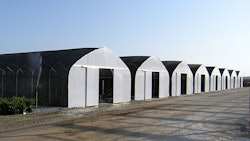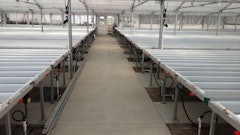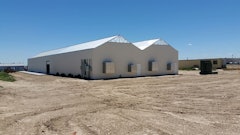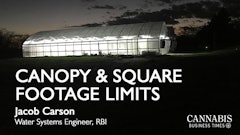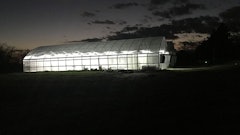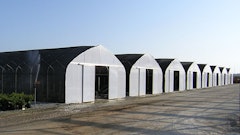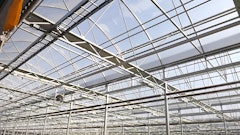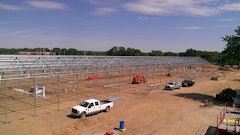
Greenhouse cannabis cultivation is not a one-size-fits-all operation. Based on what you’re cultivating, different needs will arise that you’ll need to accommodate for in your blueprint plan. Jacob Carson of RBI breaks down the special considerations to make as you design your business’s greenhouse.
Cannabis Business Times: What is the best structure for each geographic region and why?
Jacob Carson, RBI: The best structure is really more dependent on the type of grow operation (and budget) and has little to do with the region. For example, our HighLite Venlo is ideal for medicinal marijuana operations because it allows for higher levels of technology and customization than our Phantom design, which is better suited to someone just entering the market and looking to get up and running quickly.
CBT: How can you design your structure/components to account for weather elements?
JC: With humidity, you’ll need to consider:
Mechanical cooling - We generally use chilled water mechanical cooling, which is a fan coil unit (FCU) that receives cold water from a chiller. A fan blows air across the cold coils, cooling the air. Since cool air can hold less moisture than hot air, water tends to condense on the cold coils – that means that the cold air leaving the FCU will have a higher relative humidity, but less moisture overall. You can use these coils to dehumidify by equipping them with a reheat coil after the cooling coil; so the hot and humid air will be cooled down, which ‘squeezes’ moisture out onto the cold coils (which we collect and reuse in our irrigation systems), then the cooled air will pass over coils filled with hot water, which raises the temperature of the air back to where we want it. When the air is reheated, the moisture condensed on the cooling coils is already gone, so you have effectively lowered the air’s relative humidity without changing its temperature.
For dryness, keep in mind these automated systems:
Evaporative pad – Water cascades down a membrane, and air is drawn across it, which evaporates the air – this lowers temperature by raising humidity. The water absorbs energy (heat) to change phases from liquid to gas. The higher the humidity already in the air, the less “room” there is for more water to evaporate – that’s why both evaporative pads and high-pressure fogging systems become ineffective for cooling at high levels of humidity. Do not use in humid environments.
High pressure fog (HPF) – Water is forced through tiny nozzles to create a superfine mist (actually a fog if functioning properly – anywhere from misters in grocery store produce sections to actual fog will work well enough). This fog is made up of tiny-tiny water particles which, due to the huge amount of surface area, evaporate almost instantly. Thus, the thermodynamic function of HPF is quite similar to cooling pads; both are examples of evaporative cooling. Where an evaporative pad cooling system runs continuously, HPF systems work in bursts as needed. HPF is used more for increasing humidity since it is easier to control in that way, while cooling pads are typically used for cooling.
Deep water irrigation – Deep water irrigation involves large amounts of water surface area, which is the only part of a body of water where evaporation occurs under normal conditions. More evaporation = higher humidity.
For high heat, also consider an Evaporative pad, Mechanical cooling and High pressure fog.
In extreme cold, think about designing for:
Tall gutter height—allows for a larger buffer zone. The volume of the greenhouse will increase more than the surface area when the greenhouse’s height increase. Therefore in extreme cold there will be less potential for cold shock to the plants.
Boiler system – Produce hot water for hydronic heat. (Hydronic definition: a cooling or heating system in which heat is transported using circulating water.)
Perimeter heat pipes (Hydronic heat) – These are pipes full of hot water that course around the perimeter of a greenhouse. Perimeter heating pipes radiate heat like a home radiator, but they also form a kind of barrier to the cold of the greenhouse walls. Instead of heat being leached from your crops, it will first be sucked out of the perimeter pipes, allowing you to maintain your desired crop temperature.
Underbench heat – Same deal as perimeter heat pipes, but these run underneath grow benches. This allows for temperature control where it matters most: at the crop itself.
Floor heating – a different flavor of underbench heating, but the pipes are embedded inside the floor. This tends to provide a more even heat to the entire greenhouse floor (assuming you have enough hydronic pipes evenly distributed), which helps prevent microclimates from forming.
Gutter heat – Yet another form of hydronic heat (which are usually used together. In one greenhouse, you will probably have perimeter, underbench, and gutter heating pipes). Gutter pipes serve two main purposes: to heat from above (mitigating heat loss through the roof), and to melt snow on the roof (which keeps the structure from exceeding its designed snow load, which would threaten its integrity and could possibly lead to collapse).
Unit heaters – A good option for backup supplemental heating.
For snow and ice, keep in mind:
Increased barring capacity of greenhouse structure (bigger trusses, more posts).
Hydronic top heating to help melt snow/ice on roof.
And for wet/muggy climates:
Make sure the humidity controls are designed accordingly. For a cannabis crop, fan and pad will not get the job done if the outside humidity is higher than 60 percent.
See ‘Humidity’ section above. Bear in mind that roof vents are not ideal for use in the rain.










